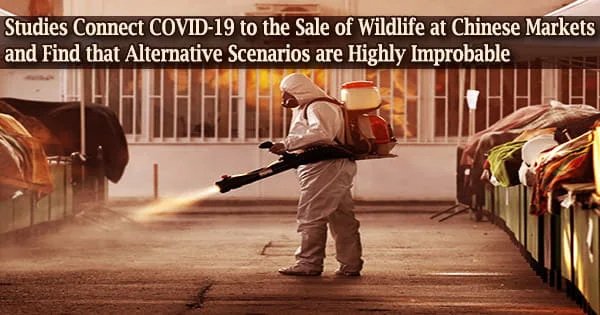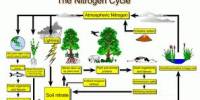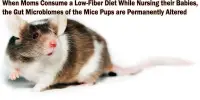The COVID-19 epidemic, which has claimed 6.4 million lives since it started almost three years ago, was most likely caused by live animals sold at the Huanan Seafood Wholesale Market, according to a global team of academics.
International teams of researchers, under the direction of the University of Arizona virus evolution expert Michael Worobey, have pinpointed the origin of the pandemic to a market in Wuhan, China, where foxes, raccoon dogs, and other live mammals susceptible to the virus were sold live just before the pandemic started. After initially being made public in pre-print forms in February, their findings were later published in two papers in the journal Science.
The publications essentially rule out alternate hypotheses that have been put up as possible causes of the pandemic. They have since undergone peer review and incorporate additional analysis and findings. The authors also come to the conclusion that two distinct transmission occurrences at the Huanan market in late November 2019 are most likely what caused the first animal-to-human transfer.
One investigation examined the sites of the earliest confirmed COVID-19 infections as well as swab samples collected from surfaces at various market locations. The other concentrated on SARS-CoV-2 genomic sequences from samples taken from COVID-19 patients in China during the early stages of the pandemic.
The first study looked at the geographic distribution of COVID-19 patients in the first month of the outbreak, December 2019, and was headed by Worobey and Kristian Andersen from Scripps Research Institute in San Diego, California. Nearly all of the 174 COVID-19 cases reported by the World Health Organization in that month 155 of which were in Wuhan were located by the researchers.
In contrast to later cases, which were widely spread around Wuhan, a city of 11 million people, the analysis revealed that these patients were concentrated closely around the Huanan market. Notably, the researchers discovered that a startling proportion of early COVID patients who had no known relationship to the market that is, they did not shop or work there actually lived close to the market.
“This supports the idea that the market was the epicenter of the epidemic,” Worobey said, “with vendors getting infected first and setting off a chain of infections among community members in the surrounding area.”
“In a city covering more than 3,000 square miles, the area with the highest probability of containing the home of someone who had one of the earliest COVID-19 cases in the world was an area of a few city blocks, with the Huanan market smack dab inside it,” said Worobey, who heads UArizona Department of Ecology and Evolutionary Biology.
It is important to realize that all these cases were people who were identified because they were hospitalized. None were mild cases that might have been identified by knocking on doors of people who lived near the market and asking if they felt ill. In other words, these patients were recorded because they were in the hospital, not because of where they lived.
Michael Worobey
This conclusion was supported by another finding: When the authors looked at the geographical distribution of later COVID cases, from January and February 2020, they found a “polar opposite” pattern, Worobey said.
The later occurrences occurred in regions of Wuhan with the largest population densities, in contrast to the cases from December 2019 that “mapped like a bullseye” on the market.
“This tells us the virus was not circulating cryptically,” Worobey said. “It really originated at that market and spread out from there.”
Worobey and his associates addressed the question of whether health authorities discovered cases surrounding the market merely because that’s where they looked, which was an important addition to their earlier findings.
“It is important to realize that all these cases were people who were identified because they were hospitalized,” Worobey said. “None were mild cases that might have been identified by knocking on doors of people who lived near the market and asking if they felt ill. In other words, these patients were recorded because they were in the hospital, not because of where they lived.”
Worobey’s team went one step further to eliminate any leftover possibility of bias: starting at the market, they started deleting cases from their analyses, moving further away from the market as they went, and ran the stats again. The result: Even when two-thirds of cases were removed, the findings were the same.
“Even in that scenario, with the majority of cases, removed, we found that the remaining ones lived closer to the market than what would be expected if there was no geographical correlation between these earliest COVID cases and the market,” Worobey said.
After Huanan market was shut down, swab samples were gathered from market surfaces like flooring and cages. SARS-CoV-2 positive samples were substantially more frequent in areas with live animal markets.
Red foxes, hog badgers, and raccoon dogs were among the species sold alive at the Huanan market in the days before the first instances of COVID-19 were discovered, according to the researchers. These creatures are now known to be vulnerable to SARS-CoV-2.
The researchers created a thorough market map and demonstrated a clear relationship between SARS-CoV-2-positive samples reported by Chinese researchers in early 2020 and the western section of the market, where live or recently butchered animals were traded in late 2019.
“Upstream events are still obscure, but our analyses of available evidence clearly suggest that the pandemic arose from initial human infections from animals for sale at the Huanan Seafood Wholesale Market in late November 2019,” said Andersen, who was a co-senior author of both studies and is a professor in the Department of Immunology and Microbiology at Scripps Research.
Virus likely jumped from animals to humans more than once
Jonathan Pekar, Joel Wertheim, and Marc Suchard from the University of California, San Diego, along with Andersen and Worobey, co-led the second study, which examined SARS-CoV-2 genomic data from early patients.
Based on the oldest collected genomes, the researchers integrated epidemic modeling with early evolution investigations of the virus. They came to the conclusion that the pandemic, which at first featured two barely different SARS-CoV-2 lineages, most likely resulted from at least two different infections of people by animals at the Huanan market in November and maybe December 2019.
The studies also revealed that there were numerous other animal-to-human viral transmissions at the market during this time that did not emerge as registered COVID-19 cases.
The authors developed a framework for the evolution of the SARS-CoV-2 viral lineages using a method known as molecular clock analysis, which relies on the regularity with which genetic changes take place across time. They discovered that the molecular clock data would be incompatible with a scenario in which the virus was just once introduced into humans as opposed to several times.
According to earlier research, the virus A, which is closely related to viral relatives in bats, gave rise to the B lineage. The two lineages most likely transitioned from animals to humans separately, both in the Huanan market, in accordance with the new data, according to Worobey.
“Otherwise, lineage A would have had to have been evolving in slow motion compared to the lineage B virus, which just doesn’t make biological sense,” said Worobey.
The two investigations show that COVID-19 spread from animals to people at the Huanan market, most likely after the animals had been exposed to coronavirus-carrying bats in the wild or on Chinese farms.
According to the researchers, in order to reduce the risk of pandemics in the future, scientists and public officials should work to gain a better knowledge of the wildlife trade in China and other countries. They should also support more thorough testing of live animals sold in marketplaces.
The National Science Foundation and the National Institutes of Health both contributed funding to the study.
















